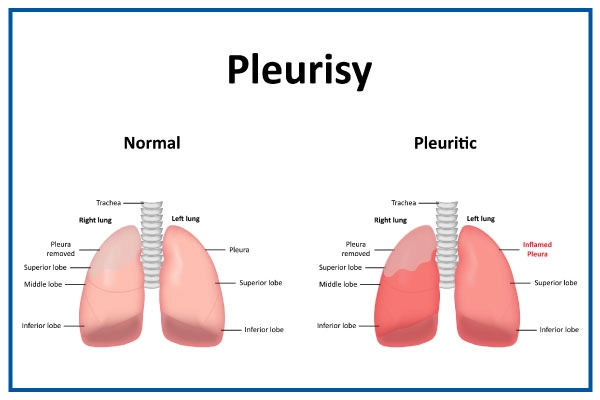Pleurisy: Overview
Pleurisy, also known as Pleuritis, is inflammation of the pleura, which is a sheet-like layer that covers the lungs. The pleura inflammation leads to pain, which worsens with deep breathing and coughing
The pleura is a thin membrane that borders the chest cavity and the outside of the lungs. Inflammation of these two tissue layers is known as pleurisy. Between the chest lining and the membrane that lines the lungs is a narrow region known as the pleural space. Let us look at all the other symptoms, its causes, complications, preventions, diagnosis and treatment in detail.

Symptoms of Pleurisy
Signs and symptoms of pleurisy includes:
- Sharp and stabbing pain in the chest area, often in the lower part.
- Deep inhalation, sneezing, or coughing causes the two layers of the pleura to rub against one another, which makes the pain greater. It can be somewhat eased when the patient sleeps on the afflicted side
- The presence of additional symptoms depends on the underlying disease. These include fever andchills when an infection is present. A persistent cough during lung infection, rashes, and joint discomfort occur when connective tissue disorders are present.
Causes of Pleurisy
Pleurisy is frequently seen as a symptom rather than a disease. Sometimes it is impossible to know the precise cause of pleurisy. The following conditions are frequently linked to pleurisy :
- Thoracic endometriosis
- Trauma to the chest
- Pneumothorax
- Rheumatoid arthritis
- Pneumonia
- Aortic dissection
- Acute pericarditis
- Pulmonary embolism
- Familial Mediterranean fever
- Lupus
Cancerous tumours such as mesothelioma, pleural lymphoma, angiosarcoma of the pleura, pleuropulmonary blastoma, and synovial sarcoma
Risk factors of Pleurisy
Pleurisy risk factors include:
- Intestinal inflammation, such as Crohn's disease and ulcerative colitis
- Lymphangioleiomyomatosis
- lung cancer, such as mesothelioma, or lymphoma
- Pancreatitis
- Autoimmune diseases, such as lupus or rheumatoid arthritis
Complications
Pleurisy complications can be very dangerous. They consist of:
- Pleural effusion: Pleural effusion is a disorder that occurs when an excessive amount of fluid accumulates between the two layers of the pleura, placing pressure on the lungs and making breathing difficult. Atelectasis can also occur, which is the collapse of a portion of the lungs.
- Empyema: In this condition, the pleural space fills with pus. It is mostly caused by a bacterial infection, which might make breathing more difficult because of pressure build-up, and this infection may spread to other organs.
- Sepsis: It is the body's overwhelming and extreme response to an infection. It is a serious medical emergency.
- Septic shock: Sepsis is life-threatening when it causes a decrease in blood pressure.
Diagnosis of Pleurisy
The doctor will perform a thorough medical history check, physical examination, and numerous diagnostic procedures, such as pleural fluid analysis, to determine if a patient has pleurisy or another pleural illness.
- Blood test: A blood test looks for signs of infection or autoimmune disorders such as lupus or rheumatoid arthritis.
- Computerized tomography (CT): Computerized tomography (CT): This looks for different pleuritic causes. A blood clot in the lung can be seen via a chest CT. Pneumo-embolism is the medical term for this ailment. It is possible to detect hemothorax that can be brought about by lung cancer, a chest injury, or a chest operation.
- Electrocardiogram (ECG or EKG): Electrocardiogram (ECG or EKG): An electrocardiogram (ECG or EKG) may be advised to rule out certain cardiac conditions as the cause of chest discomfort.
- Thoracocentesis: It involves removing and examining a small sample of pleural fluid for testing.
- Bronchoscopy: It is a diagnostic procedure to directly examine the airways inside the lungs using a thin, lighted tube (bronchoscope).
- ABG tests: It shows how well the lungs are absorbing oxygen.
Treatment for Pleurisy
The goal of pleurisy treatment is to cure the underlying issue. The doctor may recommend the following medicines to treat pleurisy:
- Antibiotics: If a bacterial infection is the cause of pleurisy, antibiotics are used to eradicate the germs and treat pleurisy.
- Antifungals: If the lungs and pleura are infected with fungus.
- NSAIDs: Non-steroidal anti-inflammatory medicines, or NSAIDs, can be used to alleviate pain. Examples include acetaminophen (paracetamol) and ibuprofen.
- Antitussives: These are medicines that treat coughs. The doctor can prescribe codeine-containing cough syrups.
- Anticoagulants: These are drugs that dissolve blood vessel clots. Anticoagulants may be used if the pleurisy is due to a blood clot (as in pulmonary embolism).
- Diuretics: Diuretics are recommended to treat pleural effusion and improve breathing.
- Bronchodilators: These medications are used to treat asthma and are often administered via inhalers. To expand the airways and improve breathing.
